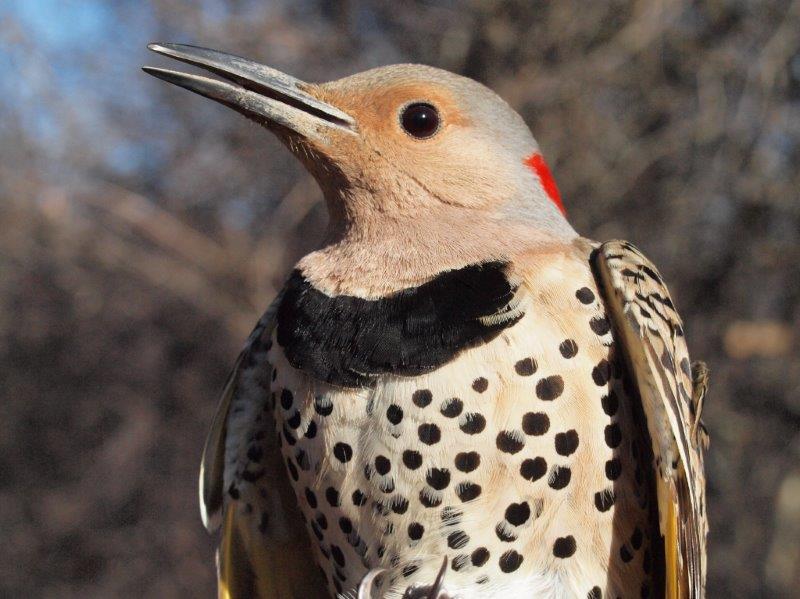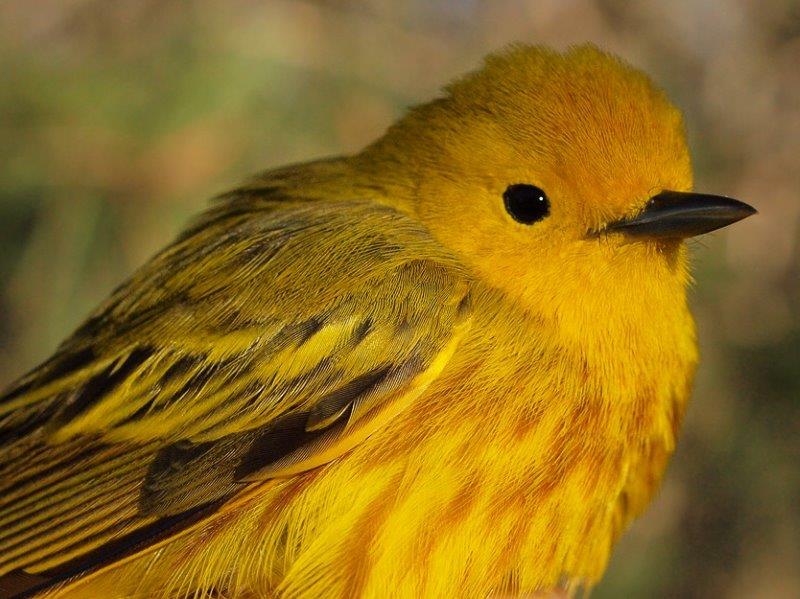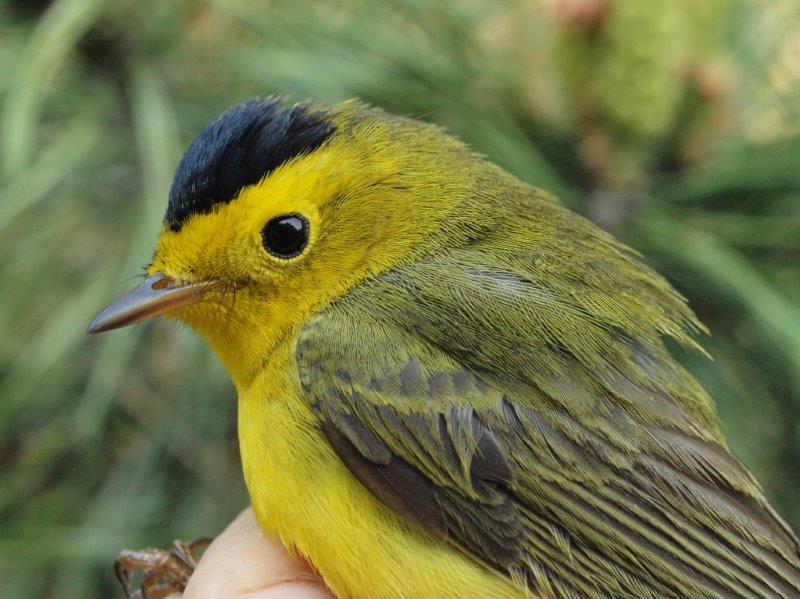Week 1 (March 28 – April 3)

Patches of snow remaining in the woods on a sunny census walk during the first week of the spring season (Photo by Betsy McFarlane)
| THIS WEEK | THIS FALL | 2006 TOTAL | SITE TOTAL | |
|---|---|---|---|---|
| # birds (and species) banded | – | – | 193 (14) | 58828 (119) |
| # birds (and species) repeat | – | – | 104 (9) | 12119 (85) |
| # birds (and species) return | – | – | 37 (9) | 1940 (51) |
| # species observed | 42 | 42 | 53 | 211 |
| # net hours | – | – | 72.7 | 115618.6 |
| # birds banded / 100 net hours | – | – | 265.5 | 50.7 |
Observers: Jean Demers, Gay Gruner, Alison Hackney, Barbara MacDuff, Betsy McFarlane, Clémence Soulard, Elise Titman, Rodger Titman
Notes: Our 12th Spring Migration Monitoring Program kicked off in fine style, with 42 species observed during the first week, breaking the previous record of 39. Among them were 10 new arrivals for the year: Turkey Vulture, Red-shouldered Hawk, American Woodcock, Yellow-shafted Flicker, Eastern Phoebe, Tree Swallow, Winter Wren, Golden-crowned Kinglet, Brown-headed Cowbird, and Common Redpoll (surprisingly absent in winter!). As usual, there will be no banding during the first three weeks of the spring program due to the frequency of cold morning temperatures.
| # individuals banded | mean # individuals observed daily |
|---|---|
| 1. Canada Goose (167) [1] | |
| 2. American Robin (44) [-] | |
| 3. Red-winged Blackbird (37) [3] | |
| 4. Snow Goose (29) [2] | |
| 5. Pine Siskin (14) [-] | |
| 6. Ring-billed Gull (14) [-] | |
| 7. Black-capped Chickadee (9) [5] | |
| 8. Song Sparrow (8) [-] | |
| 9. American Crow (6) [-] | |
| 10. Wood Duck (6) [-] |
While the top three species for March remained among the top four this week, there was otherwise considerable turnover in the list of ten most frequently observed species, with Black-capped Chickadee the only other holdover from last month. Canada Goose dominated by a wide margin, as is often the case in week 1. However, the abundance of American Robins was a surprise, as the mean daily count of 44 was nearly 5 times the historical mean for this period, and triple the previous high counted in 2009. Following in third place was Red-winged Blackbird, with a typical count for the first week of spring. Pine Siskin numbers swelled this week, with the mean daily count of 14 more than double the previous high for any week in spring. Conversely, American Crow was notable for having the lowest daily mean for week 1 in the 12 years of spring migration monitoring, following up on a winter with exceedingly few crow sightings.
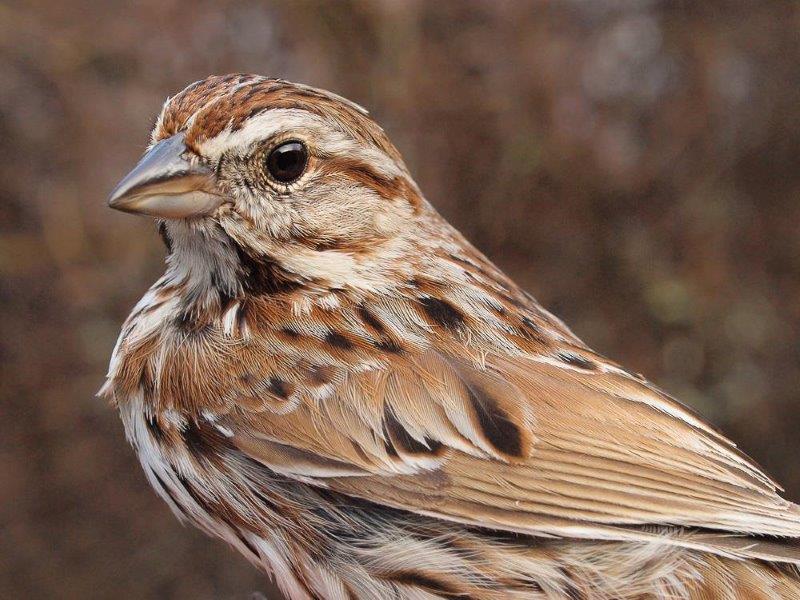
Song Sparrows are reliably one of the earliest of MBO’s migrants to return in good numbers in spring (Photo by Simon Duval)
Week 2 (April 4 – 10)

Did we say spring? At times this week the landscape was decidedly wintry, with fresh snow, and patches of ice on the water (Photo by Gay Gruner)
| THIS WEEK | THIS FALL | 2006 TOTAL | SITE TOTAL | |
|---|---|---|---|---|
| # birds (and species) banded | – | – | 193 (14) | 58828 (119) |
| # birds (and species) repeat | – | – | 104 (9) | 12119 (85) |
| # birds (and species) return | – | – | 37 (9) | 1940 (51) |
| # species observed | 39 | 46 | 56 | 211 |
| # net hours | – | – | 72.7 | 115618.6 |
| # birds banded / 100 net hours | – | – | 265.5 | 50.7 |
Observers: Claude Cloutier, Jean Demers, Gay Gruner, Alison Hackney, Barbara MacDuff, Betsy McFarlane, Clémence Soulard, Elise Titman, Rodger Titman
Notes: The second week of ‘spring’ was quite cold, and as such the influx of migrants slowed down. The number of species observed this week dropped to 39, and included only three new arrivals for the year: Great Blue Heron, Yellow-bellied Sapsucker, and Swamp Sparrow.
| # individuals banded | mean # individuals observed daily |
|---|---|
| 1. Canada Goose (88) [1] | |
| 2. American Robin (28) [2] | |
| 3. Red-winged Blackbird (28) [3] | |
| 4. Pine Siskin (23) [5] | |
| 5. Black-capped Chickadee (9) [7] | |
| 6. Song Sparrow (9) [8] | |
| 7. Golden-crowned Kinglet (8) [-] | |
| 8. Blue Jay (6) [-] | |
| 9. American Goldfinch (6) [-] | |
| 10. Northern Cardinal (6) [-] |
Reflecting the slowdown in migration this week, the top three species observed were the same as in the first week of the season, and all of them in lower numbers. However, the unprecedented Pine Siskin influx grew further, with the mean daily count of 23 individuals another 50% higher than last week’s record number! Black-capped Chickadees and Song Sparrows were seen in similar numbers to last week, but rose in the rankings due to Snow Goose and Ring-billed Gull dropping out. The bottom four in this week’s top ten were all new additions compared to last week, and are common species for early spring. Following up on last week’s commentary regarding American Crows, numbers dropped further this week to a mean daily count of only 4 individuals, again a record low for the period.

Toward the end of week 2 conditions improved and the snow melted again; this view taken from the old windmill shows the meadow as flattened by the winter; soon the fresh growth will be sprouting up again (Photo by Simon Duval)
Week 3 (April 11 – 17)
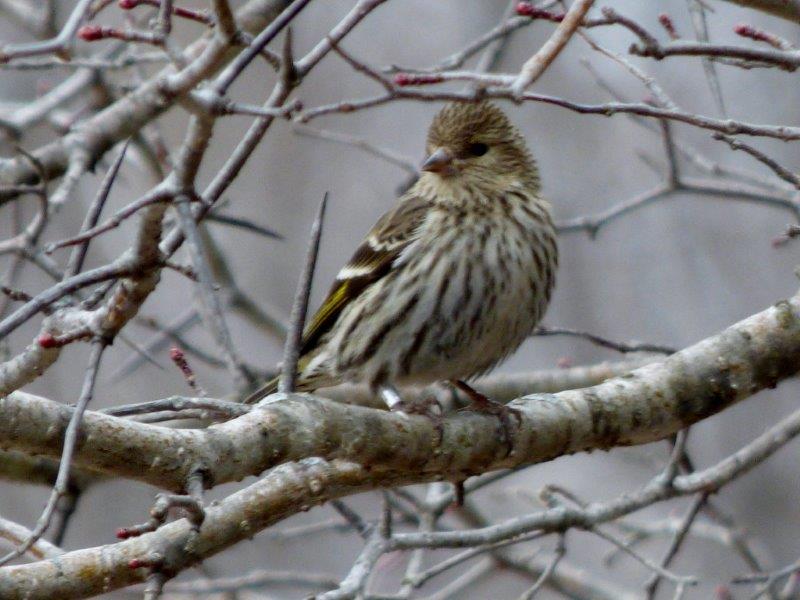
This banded Pine Siskin was part of a flock still hanging around this week, presumably having stayed since March despite the feeders being removed at the beginning of the spring monitoring season (Photo by Marcel Gahbauer)
| THIS WEEK | THIS FALL | 2006 TOTAL | SITE TOTAL | |
|---|---|---|---|---|
| # birds (and species) banded | – | – | 193 (14) | 58828 (119) |
| # birds (and species) repeat | – | – | 104 (9) | 12119 (85) |
| # birds (and species) return | – | – | 37 (9) | 1940 (51) |
| # species observed | 44 | 51 | 60 | 211 |
| # net hours | – | – | 72.7 | 115618.6 |
| # birds banded / 100 net hours | – | – | 265.5 | 50.7 |
Observers: Jean Demers, Gay Gruner, Alison Hackney, Barbara MacDuff, Betsy McFarlane, Phillip Mercier, Clémence Soulard, Elise Titman, Rodger Titman
Notes: The third week of spring began cool but ended with a gloriously warm and sunny Sunday that hinted of weather more typical of mid-May. Common Loon and Fox Sparrow made their first appearances of 2016 on that day, while Ring-necked Duck and Hermit Thrush were new additions earlier in the week.
This week we also had our annual maintenance day, with great effort from a dozen volunteers to prepare the net lanes for the start of spring banding next week, as well as trimming other vegetation, clearing fallen logs (and stacking them for next fall’s firewood), and digging trenches to clear water from the census trail. Big thanks to all those who helped out with this important work!
| # individuals banded | mean # individuals observed daily |
|---|---|
| 1. Canada Goose (52) [1] | |
| 2. Red-winged Blackbird (28) [3] | |
| 3. American Robin (27) [2] | |
| 4. Common Redpoll (23) [-] | |
| 5. Ring-billed Gull (13) [-] | |
| 6. Song Sparrow (12) [6] | |
| 7. Pine Siskin (9) [4] | |
| 8. Black-capped Chickadee (8) [5] | |
| 9. Northern Cardinal (7) [10] | |
| 10. Wood Duck (6) [-] |
For the third week in a row, Canada Goose was the top species observed, followed by Red-winged Blackbird and American Robin, although this week the blackbirds edged ahead of the robins for the first time this spring. However, the robin numbers remain above average for this point in spring, whereas the counts of the other two are well below normal. Pine Siskins finally started to taper off this week (although numbers were still higher than in any previous year), but to offset that we had an invasion of Common Redpolls – the mean daily count of 23 matches the previous high for any week in spring (week 1 in 2013) and blows away the previous record high of 1.6 per day for week 3 set in the same year. What happened to the Common Redpolls this winter remains a mystery – record numbers were counted heading southwest past Tadoussac in late fall, but only a few ever reached MBO in early winter, and points to the south did not report a giant influx either … yet clearly some are now heading back north. The other five species in the lower half of this week’s top ten are all early spring regulars at MBO.

One of the results of the maintenance day was this trench past the C nets to reduce flooding of the census trail; the next step will be to replace the old boardwalk (Photo by Marcel Gahbauer)
Week 4 (April 18-24)
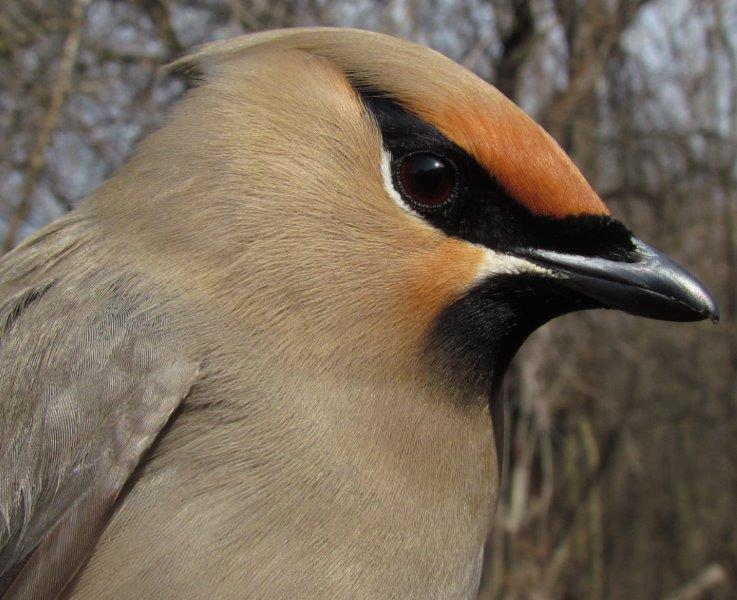
One of the incredible 14 Bohemian Waxwings banded on the first day of banding this spring (Photo by Lisa Keelty)
| THIS WEEK | THIS FALL | 2006 TOTAL | SITE TOTAL | |
|---|---|---|---|---|
| # birds (and species) banded | 126 (20) | 126 (20) | 319 (24) | 58954 (119) |
| # birds (and species) repeat | 32 (7) | 32 (7) | 136 913) | 12151 (85) |
| # birds (and species) return | 13 (8) | 13 (8) | 50 (13) | 1953 (51) |
| # species observed | 59 | 65 | 71 | 211 |
| # net hours | 450.0 | 450.0 | 522.8 | 116275.2 |
| # birds banded / 100 net hours | 28.0 | 28.0 | 61.0 | 50.6 |
Banders-in-charge: Simon Duval, Gay Gruner, Lisa Keelty
Assistants: Christine Barrie, Nicolas Bernier, Pascal Berthelot, Zoe Bonerbo, Cindy Bouchard, Manon Bourdon, Alexander Boyer, Martha Bromby, Claude Cloutier, Luke Currin, David Davey, Katelyn Depot, Frédéric Gaudreault, Francois-Xavier Grandmont, Thierry Grandmont, Alison Hackney, Joanne Hayes, Neil Henden, Lisa Keelty, Lorenzo Kleine, Barbara MacDuff, Phillip Mercier, Benoît Piquette, Catherine Russell, Paule Schetagne, Jillian Slater, Rodger Titman, Jesse White
Notes: As usual, week 4 marked the start of the spring banding season at MBO. It was a productive first week, with the 20 species banded tying the record high also reached in 2009, 2011, and 2014; the 126 individuals banded was also well above average, only short of the totals achieved in 2008 and 2014. On the other hand, diversity was unusually low with respect to species observed – the count of 59 this week matches the low for week 4 recorded in 2005 and 2011, and the cumulative total of 65 for the season is the lowest since the same count in 2005.

Although we are into the fourth week of spring migration monitoring, the meadow at MBO is still looking quite brown – though we expect it to start showing signs of green shortly. (Photo by Simon Duval)
As is often the case in week 4 of spring, an influx of new species was recorded. Partly this is a function of our level of effort expanding from census only over the first three weeks of spring to full coverage beginning at the start of week 4, but that protocol in turn is based on the wave of migration that usually reaches MBO just past mid-April. The 14 species observed this week for the first time this spring included waterbirds (Green-winged Teal, Double-crested Cormorant, and Virginia Rail), raptors (Osprey and Northern Harrier), and various songbirds (e.g., Ruby-crowned Kinglet, Chipping Sparrow). Most of these birds were also new for 2016; only Sharp-shinned Hawk, American Kestrel, and Bohemian Waxwing had been recorded already in winter.
| # individuals banded | mean # individuals observed daily |
|---|---|
| 1. Ruby-crowned Kinglet (14) [-] | 1. Canada Goose (155) [1] |
| 1. Bohemian Waxwing (14) [-] | 2. Red-winged Blackbird (44) [2] |
| 3. American Tree Sparrow (12) [-] | 3. Ring-billed Gull (32) [5] |
| 3. White-throated Sparrow (12) [-] | 4. American Robin (29) [3] |
| 5. American Robin (11) [-] | 5. Greater Snow Goose (24) [-] |
| 5. Dark-eyed Junco (11) [-] | 6. Song Sparrow (20) [6] |
| 7. Song Sparrow (9) [-] | 7. American Crow (18) [-] |
| 8. Swamp Sparrow (7) [-] | 8. Common Grackle (16) [-] |
| 8. Fox Sparrow (7) [-] | 9. American Goldfinch (12) [-] |
| 10. Golden-crowned Kinglet (6) [-] | 10. Black-capped Chickadee (11) [8] 10. White-throated Sparrow (11) [-] |
Without question, the biggest surprise on this week’s list of most frequently banded birds is Bohemian Waxwing … 14 banded this week (all on April 18!), compared to only one previously in MBO’s 11-year history (in October 2012). Ruby-crowned Kinglet tied for first place, although we banded two fewer than last year when it was only ranked third behind Fox Sparrow and Dark-eyed Junco, which were also somewhat scarcer this year. Tied for third place instead were two other sparrows – American Tree and White-throated. That was an unexpected result in that American Tree Sparrows have usually mostly already moved north by the time banding begins (mean of only 4 banded per spring season), while the long-term mean of White-throated Sparrows banded in week 4 is only 5, with the peak usually not until week 6 … is this an early sign of a large movement this year? Overall there were 6 sparrows among the top 10 species banded this week, for just the second time (also in 2013).
Canada Goose was the most numerous species observed for week 4, for the 10th time in 12 years, while Red-winged Blackbird was the runner-up for the 4th time in the past 6 years. Ring-billed Gull, American Robin, and Snow Goose rounded out the top five, and while all of them vary in abundance considerably from year to year, they are on average among the most common species at this point in spring. The remainder of the list primarily comprised common local breeders, although some individuals are likely migrants moving through (especially among the White-throated Sparrows).
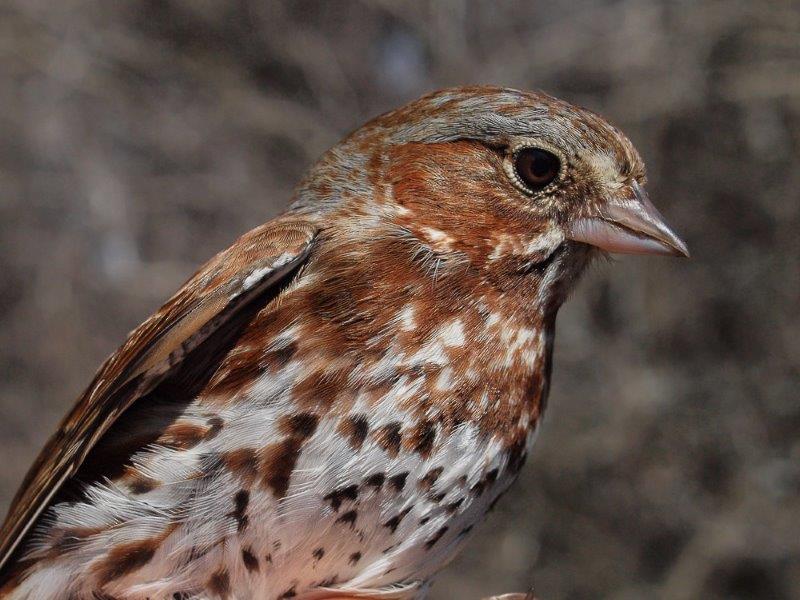
Fox Sparrow, typically one of the early-season migrants that is targeted during week 4 (Photo by Simon Duval)
Week 5 (April 25 – May 1)
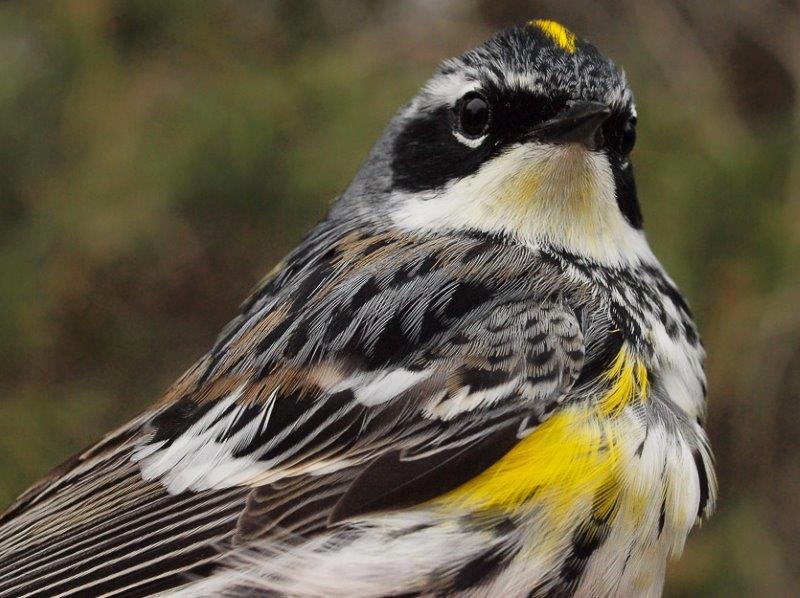
This male Yellow-rumped Warbler heralds the return of warblers to MBO – over the course of the next three weeks, we expect to observe at least another 20 species (Photo by Simon Duval)
| THIS WEEK | THIS FALL | 2006 TOTAL | SITE TOTAL | |
|---|---|---|---|---|
| # birds (and species) banded | 126 (21) | 252 (26) | 445 (29) | 59080 (119) |
| # birds (and species) repeat | 54 (13) | 86 (13) | 190 (16) | 12205 (85) |
| # birds (and species) return | 15 (8) | 28 (12) | 65 (15) | 1968 (51) |
| # species observed | 70 | 79 | 84 | 211 |
| # net hours | 555.0 | 1005.0 | 1077.8 | 116830.2 |
| # birds banded / 100 net hours | 22.7 | 25.1 | 41.3 | 50.4 |
Banders-in-charge: Simon Duval, Gay Gruner
Assistants: Christine Barrie, Pascal Berthelot, Zoe Bonerbo, Alexander Boyer, Martha Bromby, Luke Currin, David Davey, Jean Demers, Katelyn Depot, Frédéric Gaudreault, Francois-Xavier Grandmont, Thierry Grandmont, Michel Greaves, Alison Hackney, Joanne Hayes, Neil Henden, Lisa Keelty, Lorenzo Kleine, Marcel Lebeau, Barbara MacDuff, Betsy McFarlane, Phillip Mercier, Benoît Piquette, Paule Schetagne, Jillian Slater, Clémence Soulard, Patricia Stotland, Elise Titman, Rodger Titman, Christiane Tremblay, François Villeneuve
Notes: The number of birds banded this week was exactly the same as last week, and was again well above the long term average – though it is interesting to note that the past three years have been the only ones since spring migration monitoring began in 2005 during which the number banded in week 5 exceeded 100 individuals. The 21 species banded this week exceeded the previous record of 18 for week 5, set in 2009. The number of repeats so far this spring is also a record, more than 35% ahead of the pace set in 2012. Meanwhile the number of species observed this week was close to average, and boosted the season total to well within the normal range as well.
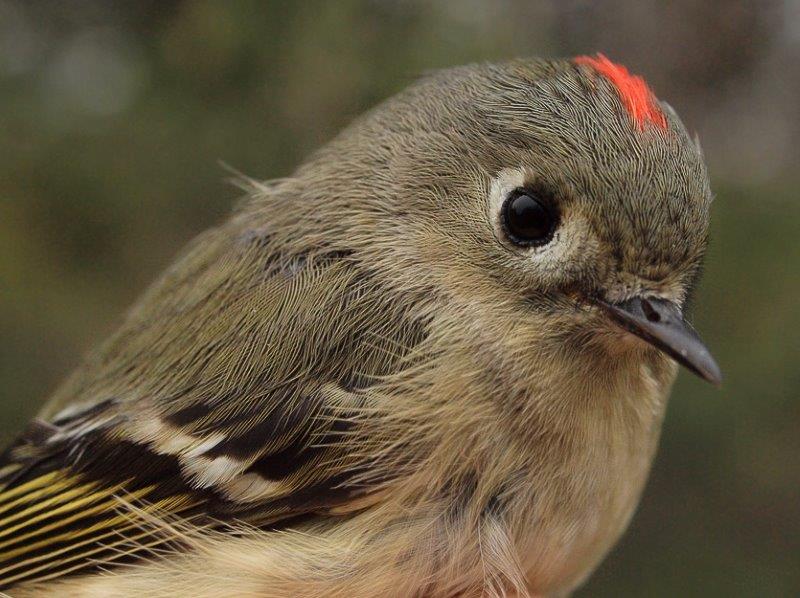
Ruby-crowned Kinglet was the bird of the week, with 38 banded, the most in a single week in spring since 53 in week 5 of 2009. (Photo by Simon Duval)
Another 13 species were new for spring this week: American Black Duck, Hooded Merganser, Broad-winged Hawk, Merlin, Wilson’s Snipe, Great Horned Owl, Northern Rough-winged Swallow, Cliff Swallow, House Wren, Brown Thrasher, Common Yellowthroat, Yellow-rumped Warbler, and White-crowned Sparrow. The April 25 arrival for Common Yellowthroat was the earliest on record at MBO; previously the species had been recorded first on April 28 or 29 for five years running (2009-2013) but then was a bit later again the past two years. This was also our first ever April record for Northern Rough-winged Swallow; the other species were close to normal in their timing. We also banded 5 species for the first time this spring: Blue Jay, Hermit Thrush, Cedar Waxwing, Yellow-rumped Warbler, and Common Grackle.
| # individuals banded | mean # individuals observed daily |
|---|---|
| 1. Ruby-crowned Kinglet (38) [1] | 1. Canada Goose (122) [1] |
| 2. White-throated Sparrow (29) [3] | 2. Red-winged Blackbird (39) [2] |
| 3. American Robin (14) [5] | 3. Ruby-crowned Kinglet (26) [-] |
| 4. Purple Finch (10) [-] | 4. White-throated Sparrow (25) [10] |
| 5. Swamp Sparrow (5) [8] | 5. American Robin (24) [4] |
| 5. Red-winged Blackbird (5) [-] | 6. Ring-billed Gull (18) [3] |
| 7. Song Sparrow (4) [7] | 7. Song Sparrow (15) [6] |
| 7. American Goldfinch (4) [-] | 8. American Crow (14) [7] |
| 9. Northern Cardinal (3) [-] | 9. American Goldfinch (13) [9] |
| 10. Hermit Thrush (2) [-] 10. Common Grackle (2) [-] |
10. Cedar Waxwing (13) [-] |
Ruby-crowned Kinglet remained the top species banded for a second week in a row; this is only the second time in 12 years that it has dominated week 5. Red-winged Blackbird was the top species in four previous years, but numbers this week were well below average, only beating out the record lows of 2009 and 2014. Instead, White-throated Sparrow was the runner-up this week, with a record number banded for this early in spring (and just one shy of the single-week spring record of 30 in week 6 of 2011). American Robin numbers were strong for a second week in a row, with more banded this week than in any previous week 5, and the total of 25 so far this spring already more than in all but two previous entire spring seasons. After a record-breaking winter with 48 banded, Purple Finches appear to be on the move again with 10 banded this week – already more than the spring season record of 8! And while the count of 2 Hermit Thrushes banded seems modest, that also matches the old spring season record set in 2012 (all of the Catharus thrushes are much scarcer at MBO in spring than fall). Small numbers of local breeders rounded out this week’s top ten.
For a second week in a row, Canada Goose and Red-winged Blackbird remained species 1 and 2 on the list of most frequently observed; this is quite typical for week 5. Ruby-crowned Kinglet shot up into third place with one of the highest mean daily counts for the species over the 12 years of spring migration monitoring at MBO (only marginally behind 28.0 in week 4 of 2008 and 27.4 in week 6 of 2011). White-throated Sparrow numbers also increased considerably this week, while American Robin, Ring-billed Gull, Song Sparrow, and American Crow all shifted slightly down in their ranks. Bohemian Waxwings appear to have now left for the summer, but Cedar Waxwings arrived in larger numbers this week, just enough to make it into the top ten.
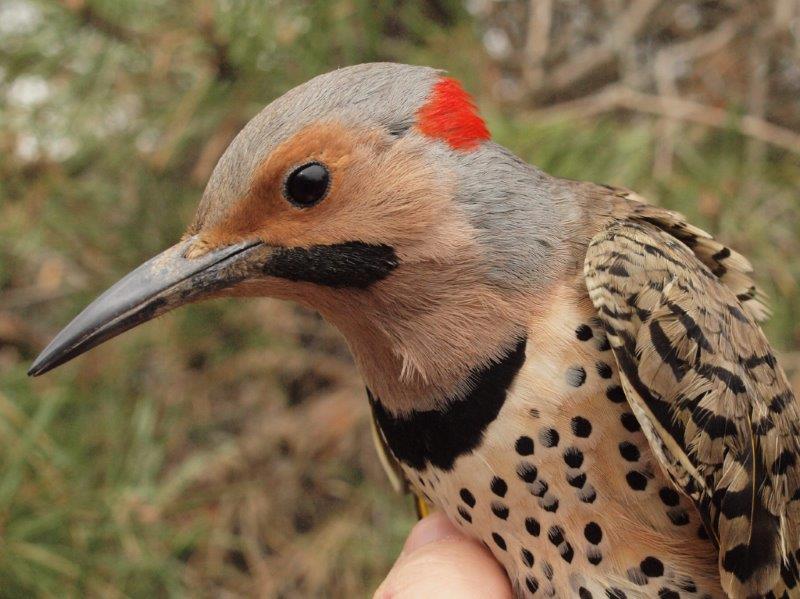
Although Yellow-shafted Flickers are fairly common at MBO, we band on average just one per spring, so we were fortunate to band this male this week, after already banding a female (below) last week. (Photos by Simon Duval)
Week 6 (May 2-8)
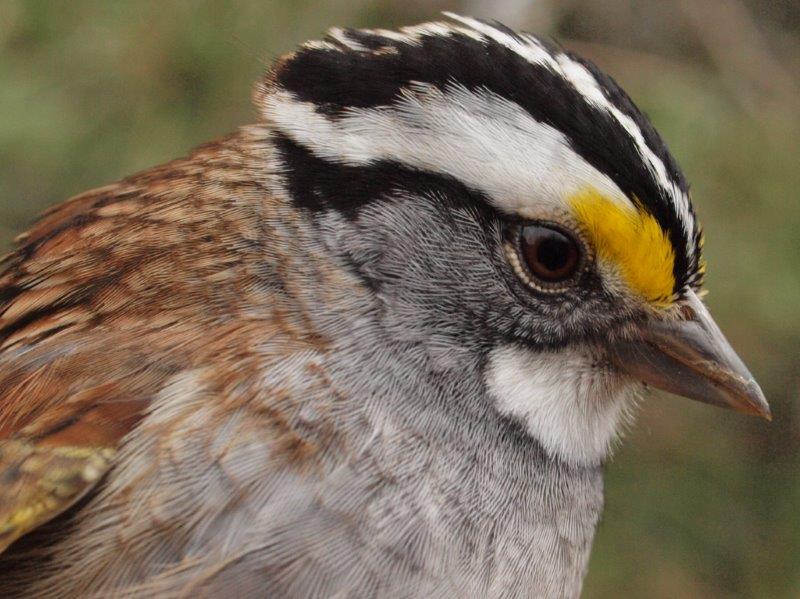
White-throated Sparrows are moving through MBO in good numbers this spring, and outnumbered all other species banded this week (Photo by Simon Duval)
| THIS WEEK | THIS FALL | 2006 TOTAL | SITE TOTAL | |
|---|---|---|---|---|
| # birds (and species) banded | 101 (16) | 353 (29) | 546 (32) | 59181 (119) |
| # birds (and species) repeat | 32 (9) | 118 (15) | 222 (17) | 12237 (85) |
| # birds (and species) return | 10 (6) | 38 (15) | 75 (16) | 1978 (51) |
| # species observed | 71 | 90 | 95 | 211 |
| # net hours | 484.0 | 1489.0 | 1561.8 | 117314.2 |
| # birds banded / 100 net hours | 20.9 | 25.4 | 36.1 | 50.3 |
Banders-in-charge: Simon Duval, Gay Gruner
Assistants: Angelika Aleksieva, Christine Barrie, Pascal Berthelot, Zoe Bonerbo, Cindy Bouchard, Alexander Boyer, Claude Cloutier, Luke Currin, David Davey, Jean Demers, Frédéric Gaudreault, Michel Greaves, Alison Hackney, Joanne Hayes, Neil Henden, Lisa Keelty, Tom Kingsbury, Kristen Lalla, Barbara MacDuff, Betsy McFarlane, Phillip Mercier, Jillian Slater, Clémence Soulard, Patricia Stotland, Elise Titman, Rodger Titman, François Villeneuve, Jesse White
Notes: There is a common perception that migration should kick into high gear with the arrival of May. Indeed, many new species typically arrive during week 6, but at the same time the early migrants taper off. For the 6th time in 12 years of our Spring Migration Monitoring Program, we banded fewer birds in week 6 than in week 5. However, the number of repeats was a record high for a second week in a row. On the other hand, the count of returns to this point in the season is our lowest since 2011. The number of species observed this week and for the season to date both remain well below average as well.
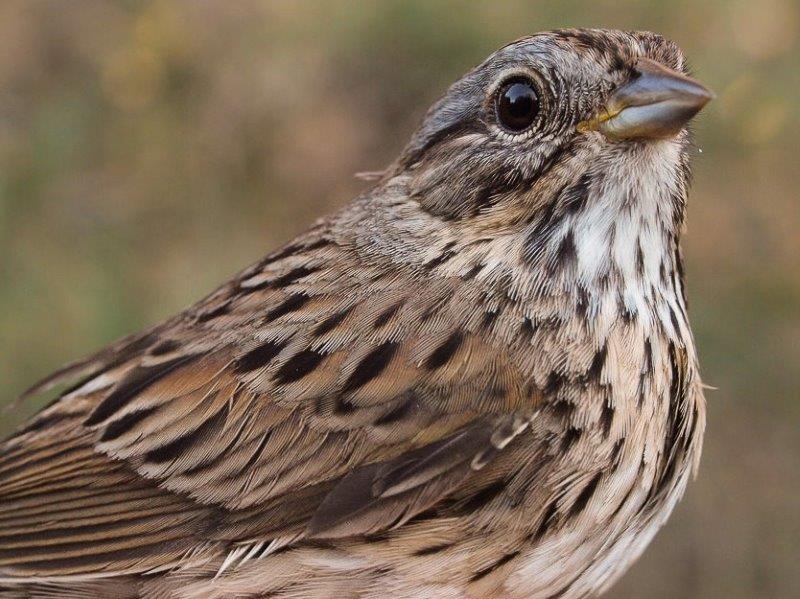
Considerably less common that White-throated Sparrow, this Lincoln’s Sparrow was the first of its kind banded at MBO this year. (Photo by Simon Duval)
The relatively low number of species observed this week reflected considerable turnover, as there were still another 11 birds recorded for the first time this season: Peregrine Falcon, Sora, Least Flycatcher, Eastern Kingbird, Blue-headed Vireo, Ovenbird, Black-and-white Warbler, Yellow Warbler, Black-throated Blue Warbler, Lincoln’s Sparrow, and Rose-breasted Grosbeak. We also banded our first Yellow Warbler, Lincoln’s Sparrow, and Brown-headed Cowbird of the year, and had 2016’s first American Robin return.
| # individuals banded | mean # individuals observed daily |
|---|---|
| 1. White-throated Sparrow (25) [2] | 1. Canada Goose (206) [1] |
| 2. Ruby-crowned Kinglet (12) [1] | 2. Greater Snow Goose (132) [-] |
| 2. Purple Finch (12) [4] | 3. Ring-billed Gull (47) [6] |
| 4. Red-winged Blackbird (10) [5] | 4. Red-winged Blackbird (42) [2] |
| 5. American Robin (8) [3] | 5. American Robin (25) [5] |
| 6. Song Sparrow (6) [7] | 6. White-throated Sparrow (23) [4] |
| 6. American Goldfinch (6) [7] | 7. American Goldfinch (17) [9] |
| 8. Cedar Waxwing (5) [-] | 8. Song Sparrow (14) [7] |
| 8. Common Grackle (5) [10] | 9. Cedar Waxwing (13) [10] |
| 10. Swamp Sparrow (4) [5] | 10. Black-capped Chickadee (12) [-] |
White-throated Sparrow and Ruby-crowned Kinglet swapped positions this week atop the list of species banded; both have cumulative totals in the mid-60s for this spring, above average already, with some more likely to come yet next week. Tied for second place this week was Purple Finch, with the remarkable influx of that species extending further. Overall, the top five species from last week were the same this week, just shuffled, with Red-winged Blackbird and American Robin rounding out the group. Most of the remainder of the top ten was also similar to last week, with the exception of Cedar Waxwing being added, while Hermit Thrush and Northern Cardinal dropped off.
For the 6th time in 12 years (but the first time since 2011), Canada Goose and Snow Goose were the top two species observed in week 6. Ring-billed Gull rose to third place this week, with the highest mean daily count for week 6 since 2006 – which was the only previous year that Red-winged Blackbird got pushed out of the top three, as was the case again this year. Aside from the arrival of large Snow Goose flocks, the biggest change in this week’s top ten was the dwindling count of Ruby-crowned Kinglets, which ranked third last week. The resident Black-capped Chickadees were just numerous enough this week to reach the end of the top ten list.
Week 7 (May 9-15)
[
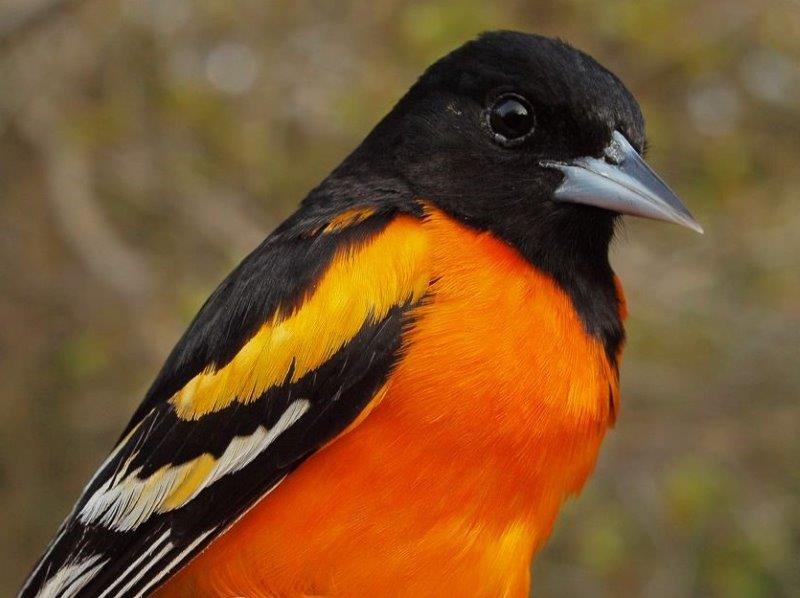 Among the many colourful birds returning to MBO this week was this striking after-second-year male Baltimore Oriole (Photo by Simon Duval) ] |
| THIS WEEK | THIS FALL | 2006 TOTAL | SITE TOTAL | |
|---|---|---|---|---|
| # birds (and species) banded | 244 (35) | 598 (51) | 791 (54) | 59426 (119) |
| # birds (and species) repeat | 31 (14) | 149 (23) | 253 (24) | 12268 (85) |
| # birds (and species) return | 15 (7) | 53 (20) | 90 (21) | 1993 (51) |
| # species observed | 103 | 123 | 128 | 211 |
| # net hours | 558.0 | 2047.0 | 2119.8 | 117872.2 |
| # birds banded / 100 net hours | 43.7 | 29.2 | 37.3 | 50.3 |
Banders-in-charge: Simon Duval, Gay Gruner
Assistants: Pascal Berthelot, Marc Boisvert, Alexander Boyer, Claude Cloutier, David Davey, Shannon Gailbraith, Frédéric Gaudreault, Michel Greaves, Alison Hackney, Joanne Hayes, Neil Henden, Lisa Keelty, Tom Kingsbury, Kristen Lalla, Barbara MacDuff, Francine Marcoux, Betsy McFarlane, Phillip Mercier, Catherine Russell, Paule Schetagne, Jillian Slater, Laurie St-Onge, Elise Titman, Rodger Titman, Christiane Tremblay, François Villeneuve, Jesse White
Notes: After a slow week 6, migration kicked into high gear in week 7, with the number of birds banded more than doubling, and the count of species observed over the course of the week increasing by 32. The 244 birds banded this week represents the third-highest week 7 total in MBO’s 12-year history – only in the past two years was it higher (273 in 2015 and 305 in 2014) … a sign perhaps that migration overall seems to be shifting slightly earlier in spring. The number of returns to date this spring is still a bit on the low side compared to recent years, but the 20 species recorded so far is a record high for this point in the season, tied with last year. Where this week really stood out was in terms of species observed, breaking the 100-species barrier for the first time before mid-May; the previous high for week 7 was 98 in 2014. Moreover, the 76 species observed on May 13 tied the old record for a single day (originally set on May 21, 2006, and matched on May 20, 2014) … but then the next day, that mark was smashed with a new high of 80 species! On May 15, the count dropped to 70, but that was still only the 14th day with a total of 70 or greater, out of over 1800 days of migration monitoring!
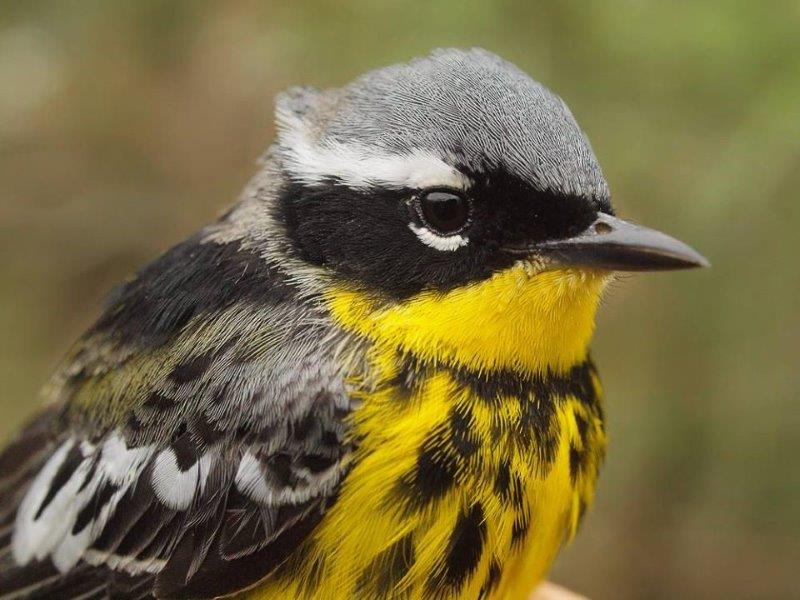
Magnolia Warbler was among the dozen warbler species that were observed for the first time this year over the past week (Photo by Simon Duval)
Among the 103 species observed this week, nearly one-third of them (33 species) were new for spring 2016. This included 2 ducks, 2 shorebirds, 3 thrushes, and 12 warblers, among others. Most notable among them was Northern Shoveler, last observed at MBO in October 2009. Also worth special mention is the Wilson’s Warbler seen on May 13, the second-earliest spring observation for the species at MBO (just one day later than the record of May 12 in 2012). There was also a big jump this week in species banded, with 22 new additions for spring 2016, including 9 warblers. As well, we had our first returns of the year for 5 species: Warbling Vireo, Yellow Warbler, Rose-breasted Grosbeak, Common Grackle, and Baltimore Oriole.
| # individuals banded | mean # individuals observed daily |
|---|---|
| 1. White-throated Sparrow (69) [1] | 1. Ring-billed Gull (165) [3] |
| 2. Ruby-crowned Kinglet (25) [2] | 2. Canada Goose (59) [1] |
| 2. Yellow-rumped Warbler (25) [-] | 3. White-throated Sparrow (42) [6] |
| 4. Red-winged Blackbird (16) [4] | 4. Red-winged Blackbird (41) [4] |
| 5. Northern Waterthrush (13) [-] | 5. Common Grackle (18) [-] |
| 6. Yellow Warbler (12) [-] | 6. Yellow-rumped Warbler (16) [-] |
| 7. Swamp Sparrow (11) [10] | 7. American Goldfinch (16) [7] |
| 8. White-crowned Sparrow (7) [-] | 8. Song Sparrow (15) [8] |
| 8. Common Grackle (7) [8] | 9. Cliff Swallow (15) [-] |
| 10. Lincoln’s Sparrow (6) [-] 10. American Goldfinch (6) [6] |
10. Cedar Waxwing (15) [9] |
Already at the end of last week, White-throated Sparrow and Ruby-crowned Kinglet were above the spring average for number of individuals banded – yet both padded those statistics substantially by remaining the top two species for a third week in a row (albeit joined this week by Yellow-rumped Warbler in a tie for second place). We have now banded 135 White-throated Sparrows this spring, far more than the previous season record of 79 in 2008, and more than three times as many as last year (39, with a peak of just 16 in week 6). This influx was surprisingly late, as the peak of White-throated Sparrow migration has been in week 5 or 6 in all but one previous year (yes, 2008). The spring record for Ruby-crowned Kinglets (92) was also set in 2008, and with a cumulative total of 89 so far this season, that mark may be surpassed next week, although like the sparrow, Ruby-crowned Kinglet is already well past the usual peak of spring migration. As for the Yellow-rumped Warblers, they do typically peak in week 7, and this was the fourth “even” year in a row that they topped the list for the week. Red-winged Blackbirds followed in fourth place, but for a second straight week, numbers were lower than in most previous years. Rounding out the top five, the 13 Northern Waterthrushes banded this week was the second highest count ever for this species in week 7. Among the remaining species in the top ten this week, the most noteworthy were two sparrows. The 6 Lincoln’s Sparrows banded may not seem like many, but it ties our record for a single week in spring, set in the same week 4 years ago. Even more surprisingly, the 11 Swamp Sparrows is a new single-week record for spring, and comes 2-3 weeks after the typical peak of spring migration.
Canada Goose was the most frequently observed species throughout the first six weeks of spring, but this week numbers tapered off and it was overtaken by Ring-billed Gull. White-throated Sparrow moved up the ranks this week, appearing in the top five for the first time ever this late in spring. Red-winged Blackbird numbers remained virtually unchanged, but were the lowest for week 7 since 2009. Common Grackle, Yellow-rumped Warbler, and Cliff Swallow were all new entries to the top ten this week, while American Goldfinch, Song Sparrow, and Cedar Waxwing hung on in similar numbers to week 6.
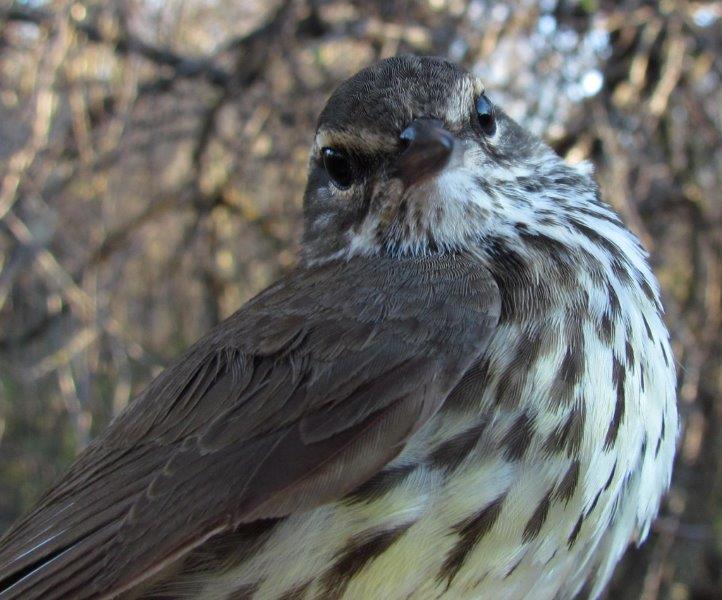
Northern Waterthrush was the second most commonly banded warbler this week, with 13 individuals (Photo by Gay Gruner)
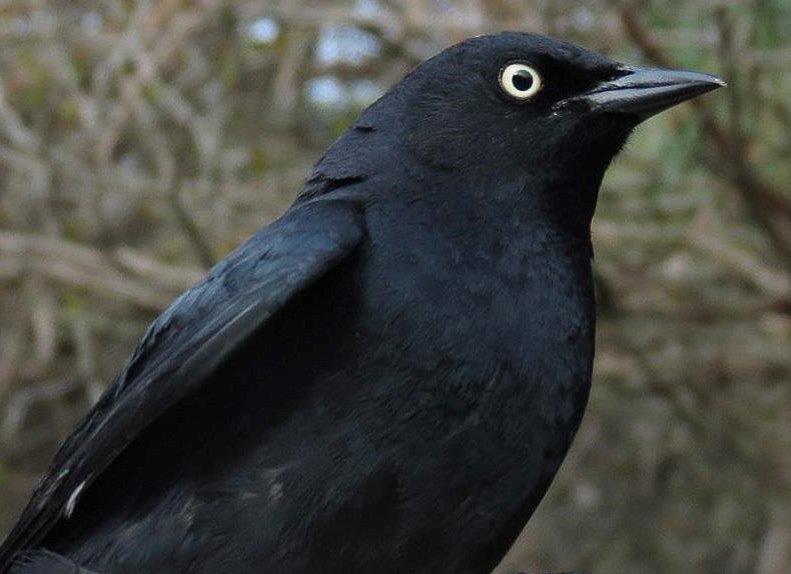
A remarkable four Rusty Blackbirds were banded this week, matching our record high for a full spring season (set in 2012), and raising our 12-year total for the species to just 19 (Photo by Gay Gruner)
Week 8 (May 16-22)
[
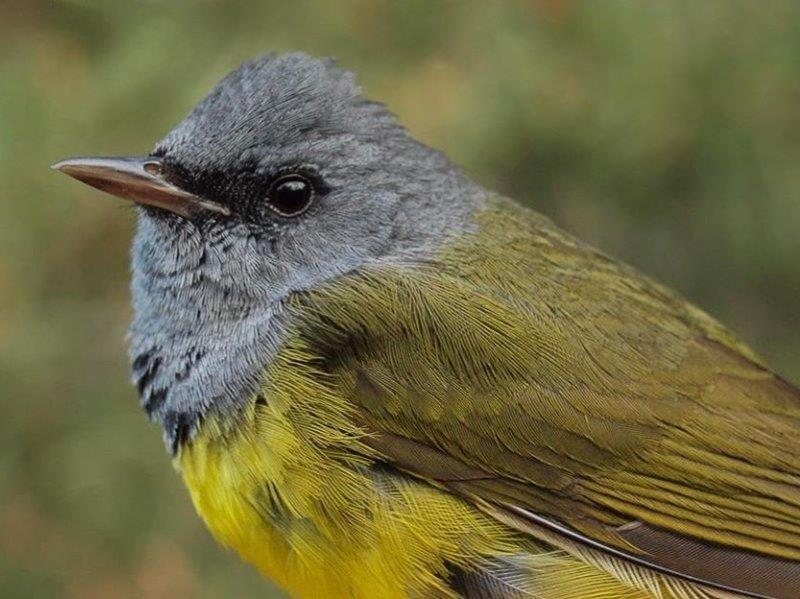 Mourning Warblers are not banded every spring at MBO, and even when they are, usually come in week 9, so this one was a highlight of our week (Photo by Simon Duval)
|
| THIS WEEK | THIS SPRING | 2016 TOTAL | SITE TOTAL | |
|---|---|---|---|---|
| # birds (and species) banded | 235 (43) | 833 (64) | 1026 (67) | 59661 (119) |
| # birds (and species) repeat | 60 (24) | 209 (34) | 313 (35) | 12328 (85) |
| # birds (and species) return | 22 (10) | 75 (22) | 112 (23) | 2015 (51) |
| # species observed | 110 | 135 | 140 | 211 |
| # net hours | 520 | 2567 | 2639.8 | 118392.2 |
| # birds banded / 100 net hours | 45.2 | 32.5 | 38.9 | 50.3 |
Banders-in-charge: Simon Duval, Gay Gruner
Assistants: Christine Barrie, Pascal Berthelot, Cindy Bouchard, Martha Bromby, Claude Cloutier, David Davey, Jean Demers, Shannon Gailbraith, Frédéric Gaudreault, Michel Greaves, Alison Hackney, Neil Henden, Lisa Keelty, Evelyne Lapointe, Marcel Lebeau, Barbara MacDuff, Francine Marcoux, Betsy McFarlane, Phillip Mercier, Catherine Russell, Jillian Slater, Clémence Soulard, Laurie St-Onge, Elise Titman, Rodger Titman, Christiane Tremblay
Notes: For a second week in a row, the numbers of individuals and species banded were well above average compared to previous years. The cumulative totals for spring are now ahead of all other years except for 2014. The number of repeats has been above average for most of spring, and the running total has now surpassed all previous years at week 8. But again this week the biggest story was the species observed. Like last week, a new record was set for the number counted over the course of the week, with 110 setting a new high for any season at MBO. Last week’s new single-day record of 80 species fell after just 4 days, with 83 species observed on May 18 – and matched on May 22. Incredibly, the daily count was between 75 and 83 for six straight days (May 17-22) – and only 5 previous days in MBO’s 12-year history reached that level (two of which were last week)!
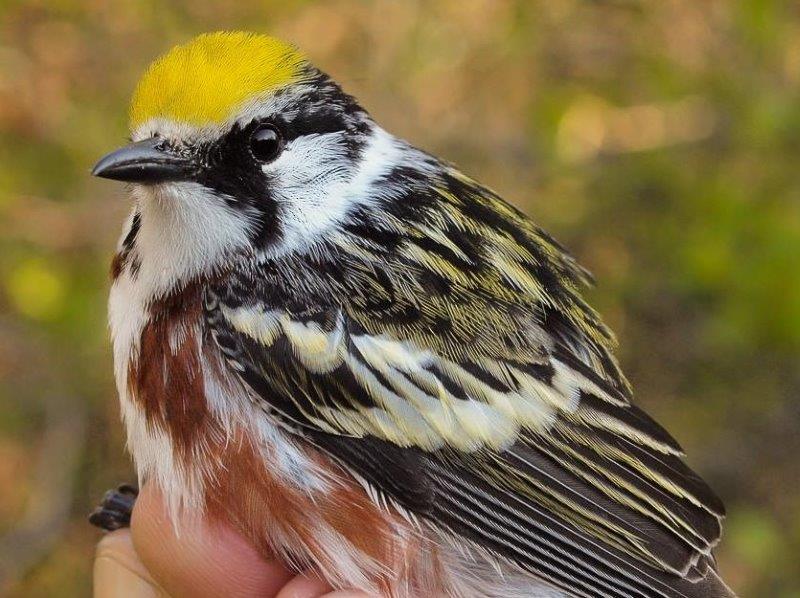
Generally an uncommon species at MBO (on average only 6 banded each spring), Chestnut-sided Warbler was banded in relatively good numbers this week, with a total of 4 individuals. (Photo by Simon Duval)
Despite last week’s big influx of “new” species for the season, this week proved there were many more yet to come. Another 13 species were observed for the first time this spring including 4 more warblers and a couple of the later Empidonax flycatchers. Perhaps more surprising was our first spring Northern Goshawk since 2012, which also happened to be the second-latest we’ve ever observed in the season. Also of note, our first spring Vesper Sparrow since 2012, and a Bank Swallow record for the second year in a row after missing them in 2013 and 2014. We also banded 13 more species for the first time in spring 2016, including 3 flycatchers and 6 warblers. Aside from that, we welcomed back our first Gray Catbird and Common Yellowthroat returns of the year.
| This week’s top 10 (last week’s rank in parentheses) | |
|---|---|
| # individuals banded | mean # individuals observed daily |
| 1. Tennessee Warbler (37) [-] | 1. Ring-billed Gull (219) [1] |
| 2. American Goldfinch (21) [10] | 2. Red-winged Blackbird (34) [4] |
| 3. Northern Waterthrush (18) [5] | 3. American Goldfinch (18) [7] |
| 4. Magnolia Warbler (17) [-] | 4. Common Grackle (17) [5] |
| 5. Yellow Warbler (16) [6] | 5. Cliff Swallow (16) [9] |
| 5. Yellow-rumped Warbler (16) [2] | 6. Yellow Warbler (12) [-] |
| 7. Red-winged Blackbird (15) [4] | 7. Song Sparrow (12) [8] |
| 8. Ruby-crowned Kinglet (8) [2] | 8. American Crow (12) [-] |
| 9. American Redstart (7) [-] | 9. Cedar Waxwing (11) [10] |
| 9. Baltimore Oriole (7) [-] | “10. Black-capped Chickadee (11) [-] 10. Tennessee Warbler (11) [-]” |
The banding results summarized above reflect a substantial change in the composition of migrants compared to last week. As they often do, Tennessee Warblers arrived en masse in week 8, enough so to take top spot this week by a wide margin (as in 2009 and 2012). While American Goldfinches are not quite as predictable in their arrival, week 8 is on average their peak in spring, and they too increased greatly this week to land in second place. Northern Waterthrush too tends to peak in week 8 and was in above-average numbers for a second week in a row, reaching the top three for the first time. Like Tennessee Warbler, Magnolia Warbler often arrives in good numbers in week 8 and this year was no exception. Yellow and Yellow-rumped Warblers rounded out a warbler-rich top 5 species with a tie. Of the other four species in the top ten this week, Ruby-crowned Kinglet stands out, as the 8 individuals banded this week brings the season total to 97, a new record for spring (and it was only the second time that Ruby-crowned Kinglet was listed in the top ten for week 8, the previous occasion being in 2005).
The turnover in species was somewhat less apparent with respect to birds observed. Ring-billed Gull continued to dominate the counts for a second week in a row, whereas the other two species from last week’s top three (Canada Goose and White-throated Sparrow) dropped off the list this week. But otherwise six more species carried over from last week, with Red-winged Blackbird, American Goldfinch, and Common Grackle leading the way. New waves of migration propelled Yellow Warbler and Tennessee Warbler into the bottom half of the top ten, while local residents American Crow and Black-capped Chickadee were just numerous enough this week to squeak back on the list for a change.
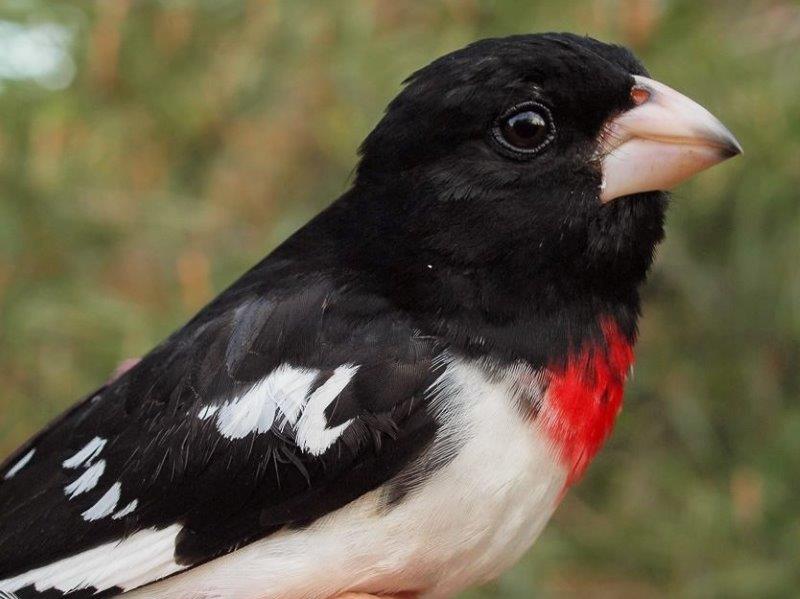
Rose-breasted Grosbeaks were rare in spring for a few years, with only one banded in each of 2011 and 2012, and none in 2013 or 2014. Last year though we banded 11 individuals, and with four this week on top of last week’s first of the season, it appears that the 2016 total will also be above average. (Photo by Simon Duval)

Our intrepid “Green Team” undertook the 2016 Great Canadian Birdathon on foot on May 20 and found 76 species. Please consider visiting (http://goo.gl/Dfn8Pl) to support the team’s fundraising efforts in support of migration monitoring.
Week 9 (May 23-29)
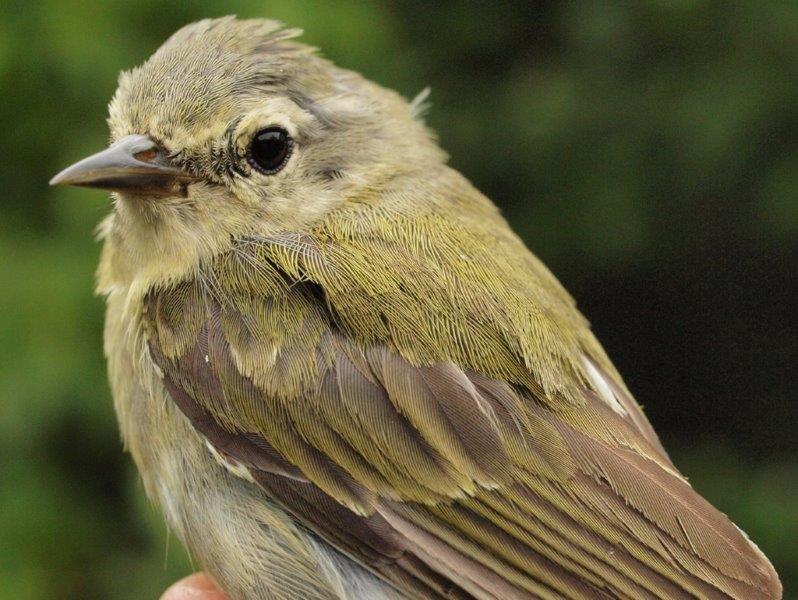
This somewhat scruffy Tennessee Warbler was among the 62 of its kind banded at MBO this week, accounting for over one-quarter of the week’s total (Photo by Simon Duval)
| THIS WEEK | THIS SPRING | 2016 TOTAL | SITE TOTAL | |
|---|---|---|---|---|
| # birds (and species) banded | 225 (33) | 1058 (67) | 1251 (70) | 59886 (119) |
| # birds (and species) repeat | 41 (18) | 250 (36) | 354 (37) | 12369 (85) |
| # birds (and species) return | 8 (6) | 83 (23) | 120 (24) | 2023 (51) |
| # species observed | 99 | 139 | 144 | 212 |
| # net hours | 544 | 3111 | 3183.8 | 118936.2 |
| # birds banded / 100 net hours | 41.4 | 34 | 39.3 | 50.2 |
Banders-in-charge: Simon Duval, Gay Gruner
Assistants: Christine Barrie, Nicolas Bernier, Pascal Berthelot, Alexander Boyer, Martha Bromby, Claude Cloutier, David Davey, Jean Demers, Shannon Gailbraith, Frédéric Gaudreault, Alison Hackney, Joanne Hayes, Neil Henden, Lisa Keelty, Evelyne Lapointe, Marcel Lebeau, Barbara MacDuff, Betsy McFarlane, Phillip Mercier, Jillian Slater, Clémence Soulard, Laurie St-Onge, Patricia Stotland, Elise Titman, Rodger Titman, Christiane Tremblay, Jesse White
Notes: After enjoying two of the busiest weeks of spring migration in MBO’s history, we would have been okay with activity tapering off in week 9 – but of course we were delighted to have results very similar to last week’s highs! We banded another 225 birds this week, the third-highest ever total for week 9. That brought us to 1058 for the season, surpassing 1000 birds banded for the third spring in a row, after failing to reach that mark for the first 9 years of the program. Correspondingly, the number of repeats is also well above average, and the number of species involved (36) is already higher than the previous record for all of spring (34 in 2014). The number of species observed tapered off somewhat from last week’s record highs, but there was still one day with 73 species reported (May 28), and the total of 99 for the week is just one short of the record for week 9 set in 2008. Despite that, the cumulative total of 139 species observed for the season to date is actually slightly below average.
After two weeks in a row with high numbers of new arrivals, that naturally tapered off this week, as we are nearing the end of spring migration already. However, among the 4 species this week that were new for the season, one stood out for never having been observed at MBO before! An Orchard Oriole was seen on May 23, one of the species we had predicted (in our Ten-year Report) that would eventually show up at MBO. Also arriving this week were a trio of typical late-May birds: Black-billed Cuckoo, Eastern Wood-Pewee, and Willow Flycatcher. We also banded our first Traill’s Flycatcher of the year (either a Willow or more likely an Alder), as well as Red-eyed Vireo and Blackpoll Warbler. The return of an American Redstart on May 27 is further evidence of this species now regularly breeding at MBO.
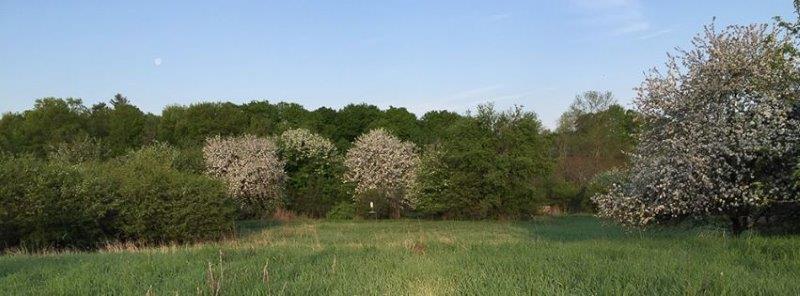
A view of the spring landscape at MBO, highlighted by the blossoming apple trees. (Photo by Simon Duval)
| # individuals banded | mean # individuals observed daily |
|---|---|
| 1. Tennessee Warbler (62) [1] | 1. Ring-billed Gull (173) [1] |
| 2. American Goldfinch (19) [2] | 2. Red-winged Blackbird (32) [2] |
| 3. Cedar Waxwing (17) [-] | 3. Cedar Waxwing (28) [9] |
| 3. Magnolia Warbler (17) [4] | 4. Tennessee Warbler (23) [10] |
| 5. American Redstart (11) [9] | 5. American Goldfinch (21) [3] |
| 6. Traill’s Flycatcher (9) [-] | 6. Cliff Swallow (21) [5] |
| 6. Gray Catbird (9) [-] | 7. American Crow (19) [8] |
| 6. Wilson’s Warbler (9) [-] | 8. Yellow Warbler (14) [6] |
| 9. Common Yellowthroat (8) [-] | 9. Common Yellowthroat (13) [-] |
| 10. Blackpoll Warbler (7) [-] | 10. Common Grackle (12) [4] |
It is proving to be another big spring for Tennessee Warbler, which topped our list of species banded for a second week in a row. While the total of 99 over the past two weeks falls well short of the season record of 142 banded in spring 2014, it is already more than double the long-term average, and appears to reflect the ongoing population boom being supported by the spruce budworm outbreak in central Quebec. American Goldfinches and Magnolia Warblers were banded in similar numbers to last week, but Cedar Waxwings came out of nowhere to tie for third place. A surprisingly high count of American Redstarts rounded out the top five; the 11 individuals banded is the second-highest weekly total for spring (only behind 12 in week 9 of 2012), and brings the season total to date to 20, a new spring record. The bottom half of the top ten features three traditional late spring migrants at MBO: Traill’s Flycatcher, Blackpoll Warbler, and Wilson’s Warbler.
Ring-billed Gull and Red-winged Blackbird numbers remained similar to last week, while American Goldfinch was actually slightly more abundant than in week 8, but slipped back two places in the ranking due to an influx of Cedar Waxwings and Tennessee Warblers. Cliff Swallows continued to be seen in good numbers most mornings, and American Crows were even more numerous than last week. Rounding out the list were a trio of species most active around the wetlands: Yellow Warbler, Common Yellowthroat, and Common Grackle.
Week 10 (May 30-June 5)
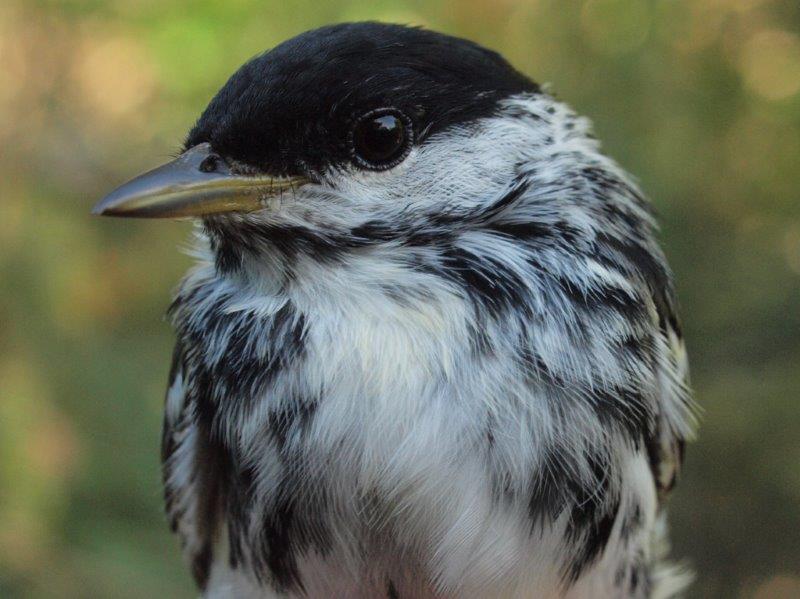
A traditional end-of-spring bird, Blackpoll Warbler was actually unusually scarce in the final week of the season this year (Photo by Simon Duval)
| THIS WEEK | THIS SPRING | 2016 TOTAL | SITE TOTAL | |
|---|---|---|---|---|
| # birds (and species) banded | 35 (16) | 1093 (67) | 1286 (70) | 59921 (119) |
| # birds (and species) repeat | 8 (5) | 258 (36) | 362 (37) | 12377 (85) |
| # birds (and species) return | 5 (5) | 88 (24) | 125 (25) | 2028 (51) |
| # species observed | 84 | 139 | 144 | 212 |
| # net hours | 232 | 3343 | 3415.8 | 119168.2 |
| # birds banded / 100 net hours | 15.1 | 32.7 | 37.6 | 50.1 |
Banders-in-charge: Simon Duval, Gay Gruner
Assistants: Christine Barrie, Pascal Berthelot, Martha Bromby, Jean Demers, Shannon Gailbraith, Alison Hackney, Joanne Hayes, Evelyne Lapointe, Barbara MacDuff, Betsy McFarlane, Phillip Mercier, Catherine Russell, Jillian Slater, Clémence Soulard, Laurie St-Onge, Elise Titman, Rodger Titman, François Villeneuve
Notes: After the whirlwind activity of the past three weeks, migration wound down quickly in this, the final week of our 2016 Spring Migration Monitoring Program. As in previous years, we only banded birds for the first three days this week, recognizing that after that the captures would be too biased by local residents over transient migrants. As always, however, we continued with census through to June 5, to document any late-lingering migrants that we could see or hear around the site. Fewer than average birds were banded this week, but our season total of 1093 still ranks as our third highest in the 12 years of our spring program, and the 67 species banded ranked fourth behind 69 in 2014 and 2015 and 68 in 2013 … there seems to be a clear pattern for higher diversity in recent years! We also ended up with the third highest count of repeats for spring (the record being 298 in 2012), but the 88 returns was the fewest in spring since 63 in 2011. Keeping with the trend of the past few weeks, the 84 species observed this week was a new record for week 10. However, we ended the season with 139 species observed, which is the fewest since 2010. Also of note, it was an unusually dry spring overall, resulting in less time than usual lost to rain – so our 3343 net hours also marks a new high for the season, far ahead of 3115 in 2010.
As week 10 is the end of our Spring Migration Monitoring Program, it was fitting that there were no new arrivals this week. The only addition to our season totals was in the returns column, where we were revisited by our first Indigo Bunting from a previous year.
| # individuals banded | mean # individuals observed daily |
|---|---|
| 1. American Goldfinch (5) [2] | 1. Ring-billed Gull (42) [1] |
| 2. Red-eyed Vireo (4) [-] | 2. Red-winged Blackbird (27) [2] |
| 3. Traill’s Flycatcher (3) [6] | 3. American Goldfinch (15) [5] |
| 3. Cedar Waxwing (3) [3] | 4. Cedar Waxwing (11) [3] |
| 3. Common Yellowthroat (3) [9] | 5. Cliff Swallow (9) [6] |
| 3. Magnolia Warbler (3) [3] | 6. Canada Goose (9) [-] |
| 7. Tennessee Warbler (2) [1] | 7. Yellow Warbler (8) [8] |
| 7. American Redstart (2) [5] | 8. Tree Swallow (8) [-] |
| 7. Yellow Warbler (2) [-] | 9. Song Sparrow (7) [-] |
| 7. Red-winged Blackbird (2) [-] | 10. Common Yellowthroat (7) [9] |
As usual, the banding list for week 10 is somewhat sparse, since nets were up only the first three days of the final week. As such, the rankings are not as informative as usual, but they reflect the presence of late season migrants such as Traill’s Flycatcher and Tennessee Warbler. Of note, American Redstart increased its new spring record to a total of 22 individuals banded. Conversely, the season total of 55 Red-winged Blackbirds banded was the lowest since 2008.
Ring-billed Gull wrapped up the season as the most abundant species observed for a fourth straight week; Red-winged Blackbird was the runner-up for the sixth time in ten weeks. American Goldfinch, Cedar Waxwing, and Cliff Swallow rounded out the top five. Among the rest of the top ten, only Canada Goose was a mild surprise, given that in most years fewer than 5 per day are observed by the end of the spring season.

